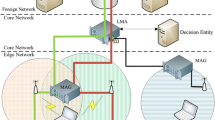Abstract
The ability of offloading selected IP data traffic from 3G to WLAN access networks is considered a key feature in the upcoming 3GPP specifications, being the main goal to alleviate data congestion in cellular networks while delivering a positive user experience. Lately, the 3GPP has adopted solutions that enable mobility of IP-based wireless devices relocating mobility functions from the terminal to the network. To this end, the IETF has standardized Proxy Mobile IPv6 (PMIPv6), a protocol capable to hide often complex mobility procedures from the mobile devices. This paper, in line with the mentioned offload requirement, further extends PMIPv6 to support dynamic IP flow mobility management across access wireless networks according to operator policies. Considering energy consumption as a critical aspect for hand-held devices and smart-phones, we assess the feasibility of the proposed solution and provide an experimental analysis showing the cost (in terms of energy consumption) of simultaneous packet transmission/reception using multiple network interfaces. The end-to-end system design has been implemented and validated by means of an experimental network setup.
Similar content being viewed by others
References
Soliman, E. H. (2009). Mobile IPv6 support for dual stack hosts and routers. Internet engineering task force, RFC 5555, June 2009.
Kempf, J. (2007). Problem statement for network-based localized mobility management (NETLMM). RFC 4830, April 2007.
Gundavelli, S., Leung, K., Devarapalli, V., Chowdhury, K., & Patil, B. (2008). Proxy Mobile IPv6. Internet engineering task force, RFC 5213, August 2008.
Bernardos C. J., Gramaglia M., Contreras L., Calderon M., Soto I. (2010) Network-based localized IP mobility management: Proxy Mobile IPv6 and current trends in standardization. Journal of Wireless Mobile Networks, Ubiquitous Computing, and Dependable Applications 1(2/3): 16–35
Wakikawa R., Kiriyama S., Gundavelli S. (2009) The applicability of virtual interface for inter-technology handoffs in Proxy Mobile IPv6. Wireless Communications and Mobile Computing 11(4): 500–507
Yokota, H., Gundavelli, S., Trung, T., Hong, Y., & Leung, K. (2010). Virtual interface support for IP hosts. Internet engineering task force, draft-yokota-netlmm-pmipv6-mn-itho-support-03.txt (work-in-progress), March 2010.
Braden, R. (1989). Requirements for internet hosts—communication layers. Internet Engineering Task Force, RFC 1122, October 1989.
Thaler, D. (2008). Evolution of the IP model. Internet engineering task force, draft-thaler-ip-model-evolution-01.txt (work-in-progress), July 2008.
Johnson, D., Perkins, C., & Arkko, J. (2004). Mobility support in IPv6. Internet engineering task force, RFC 3775, June 2004.
Narten, T., Nordmark, E., Simpson, W., & Soliman, H. (2007). Neighbor discovery for IP version 6 (IPv6). RFC 4861, September 2007.
LAN/MAN Committee of the IEEE Computer Society. (2008). IEEE Std 802.21-2008, Standards for local and metropolitan area - part 21: Media independent handover services.
Soto I., Bernardos C. J., Calderon M., Melia T. (2010) PMIPv6: A network-based localized mobility management solution. The Internet Protocol Journal, 13(3): 2–15
Kiriyama S., Wakikawa R., Xia J., Teraoka F. (2010) Context reflector for Proxy Mobile IPv6. Journal of Wireless Mobile Networks, Ubiquitous Computing, and Dependable Applications 1(2/3): 36–51
Hui S. Y., Yeung K. H. (2003) Challenges in the migration to 4G mobile systems. IEEE Communications Magazine 41(12): 54–59
Devarapalli, V., Kant, N., Lim, H., & Vogt, C. (2009). Multiple interface support with Proxy Mobile IPv6. Internet engineering task force, draft-devarapalli-netext-multi-interface-support-00.txt (work-in-progress), March 2009.
Thaler, D. (2007). Multi-link subnet issues. Internet engineering task force, RFC 4903, June 2007.
Gundavelli, Sri, Melia, Telemaco (2010). Logical interface support for multi-mode IP hosts. Internet engineering task force, draft-ietf-netext-logical-interface-support-01.txt (work-in-progress), October 2010.
Serrano, P., Bernardos, C.J., de la Oliva, A., Banchs, A., Soto, I., & Zink, M. (2010). FloorNet: Deployment and evaluation of a multihop wireless 802.11 testbed. EURASIP Journal on Wireless Communications and Networking, 10. Article ID 153102 (17 pp).
Rysavy, P. (2010). Mobile broadband capacity constraints and the need for optimization, February 2010.
Wasserman, M. (2010). Current practices for multiple interface hosts. Internet engineering task force, draft-ietf-mif-current-practices-03.txt (work-in-progress), August 2010.
Templin, F., Gleeson, T., & Thaler, D. (2008). Intra-site automatic tunnel addressing protocol (ISATAP). Internet engineering task force, RFC 5214, March 2008.
Soliman, H., Tsirtsis, G., Montavont, N., Giaretta, G., & Kuladinithi, K. (2010). Flow bindings in mobile IPv6 and NEMO basic support. Internet engineering task force, draft-ietf-mext-flow-binding-06.txt (work-in-progress), March 2010.
Qualcomm. (2010). 3G/Wi-Fi seamless offload (whitepaper), March 2010.
Imai, N., Isomura, M., & Idoue, A. (2009). Coordination path control method to reduce traffic load on NGN access gateway. In 13th International conference on intelligence in next generation networks, 2009 (ICIN 2009) October 2009.
Bernardos, C. J., Melia, T., Seite, P., & Korhonen, J. (2010). Multihoming extensions for Proxy Mobile IPv6. Internet engineering task force, draft-bernardos-mif-pmip-02.txt (work-in-progress), March 2010.
Koodli, R., & Chowdhury, K. (2009). Flow handover for Proxy Mobile IPv6. Internet engineering task force, draft-koodli-netext-flow-handover-01.txt (work-in-progress), October 2009.
Hui, M., & Deng, H. (2010). PMIPv6 multihoming extension and synchronization in LMA and MAG. Internet engineering task force, draft-hui-netext-multihoming-01.txt (work-in-progress), March 2010.
Hui, M., Chen, G., & Den, H. (2010). Service flow identifier in Proxy Mobile IPv6. Internet engineering task force, draft-hui-netext-service-flow-identifier-02.txt (work-in-progress), March 2010.
Wakikawa, R., Kiriyama, S., & Gundavelli, S. (2008). The use of virtual interface for inter-technology handoffs and multihoming in Proxy Mobile IPv6. In Proceedings of the international conference on mobile technology, applications, and systems. NY, USA: ACM New York.
Bernardos, C. J. (2010). Proxy Mobile IPv6 extensions to support flow mobility. Internet engineering task force, draft-bernardos-netext-pmipv6-flowmob-01.txt (work-in-progress), October 2010.
Author information
Authors and Affiliations
Corresponding author
Additional information
The research of Carlos J. Bernardos, Antonio de la Oliva, Telemaco Melia and Fabio Giust leading to these results has received funding from the European Community’s Seventh Framework Programme (FP7-ICT-2009-5) under grant agreement n. 258053 (MEDIEVAL project). Carlos J. Bernardos and Maria Calderon have also received funding from the Ministry of Science and Innovation of Spain, under the QUARTET project (TIN2009-13992-C02-01).
Rights and permissions
About this article
Cite this article
Melia, T., Bernardos, C.J., de la Oliva, A. et al. IP Flow Mobility in PMIPv6 Based Networks: Solution Design and Experimental Evaluation. Wireless Pers Commun 61, 603–627 (2011). https://doi.org/10.1007/s11277-011-0423-3
Published:
Issue Date:
DOI: https://doi.org/10.1007/s11277-011-0423-3




